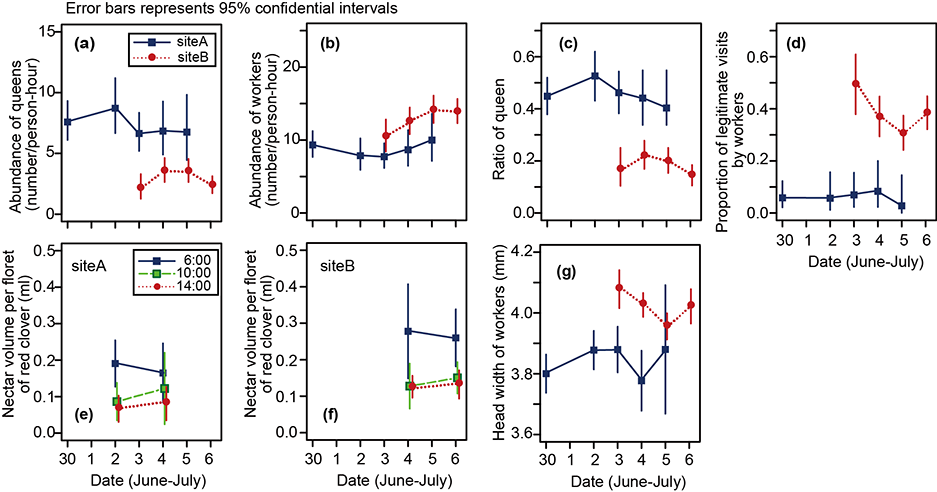
Ecological Archives E096-121-A2
Eri Z. Kadoya and Hiroshi S. Ishii. 2015. Host manipulation of bumble bee queens by Sphaerularia nematodes indirectly affects foraging of non-host workers. Ecology 96:1361–1370. http://dx.doi.org/10.1890/14-0036.1
Appendix B. Results of the between-day survey conducted at two sites without queen removal procedure.
Site information: Site IDs (A and B) correspond to those shown in Fig. 1 and Table A1. These two sites were 1.0 km apart from one another. Both sites consisted of red clover (Trifolium pratense) and their areas were approximately 1750 m² (site A) and 2000 m² (site B). Inflorescence density measured 17.46 ± 12.23/m² (site A) and 15.69 ± 12.74/m² (site B) (mean ± SD: calculated from 26 1-m² squares uniformly sampled from each site). Methods: We observed Bombus terrestris from 30 July to 5 July 2009 at site A and from 3 to 6 July 2009 at site B and recorded the caste and number of each individual. During the period, we conducted similar survey with the queen removal experimental site described in the main text, except that the sites consisted almost exclusively of red clover, that queen removal was not conducted (all captured queens were released within an hour of their capture, and that invested effort time was not evenly allocated within a day. Results: (Table B1) At site A, we recorded in total 255 individuals that had been marked previously during the survey, and none of these had been marked at site B. At site B, we recorded total 499 individuals that had been marked previously, and only 5 of them had been recorded at site A. (Fig. B1) Neither (a) the abundance of B. terrestris queens, (b) that of the workers, (c) ratio of queens, (d) proportion of legitimate visits to red clover by workers, (e and f) nectar standing crop per floret of red clover, nor (g) the head width of workers showed significant directional changes between days (P > 0.05 in all cases: the statistical analyses were conducted as similar to that of queen removal experiments in the main text), whereas all of them differed significantly among the sites (P < 0.01 in all cases). Conclusion: Individual B. terrestris rarely moved between flower patches that were at least 1.0 km apart, at least within several days. The abundance of B. terrestris queens, that of the workers, ratio of queens, proportion of visits to red clover by workers, nectar standing crop per floret of red clover, and the head width of workers would be characteristic for each study site.
Table B1.
Site ID |
Date (2009) |
||||||
30 June |
2 July |
3 July |
4 July |
5 July |
6 July |
||
A |
Total number of B. terrestris |
233 (111) |
116 (61) |
180 (84) |
117 (53) |
85 (41) |
|
Number of B. terrestris |
143 (76) |
71 (36) |
42 (21) |
0 (0) |
0 (0) |
|
|
Number of B. terrestris |
77 (34) |
45 (25) |
76 (29) |
35 (9) |
22 (8) |
|
|
Number of B. terrestris |
0 (0) |
0 (0) |
0 (0) |
0 (0) |
0 (0) |
|
|
B |
Total number of B. terrestris |
|
|
157 (27) |
298 (63) |
287 (57) |
328 (49) |
Number of B. terrestris |
|
|
76 (19) |
122 (25) |
86 (14) |
18 (18) |
|
Number of B. terrestris |
|
|
2 (0) |
2 (1) |
0 (0) |
1 (1) |
|
Number of B. terrestris |
|
|
25 (1) |
144 (34) |
158 (37) |
167 (12) |
|
Numbers shown in parentheses indicate number of queens.

Figure B1.